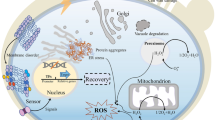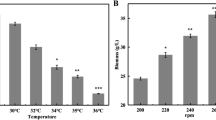Abstract
Three different transport systems exist to accumulate a sufficient amount of potassium cations in yeasts. The most common of these are Trk-type transporters, which are used by all yeast species. Though most yeast species employ two different types of transporters, we only identified one gene encoding a potassium uptake system (Trk-type) in the genome of the highly osmotolerant yeast Zygosaccharomyces rouxii, and our results showed that ZrTrk1 is its major (and probably only) specific potassium uptake system. When expressed in Saccharomyces cerevisiae, the product of the ZrTRK1 gene is localized to the plasma membrane and its presence efficiently complements the phenotypes of S. cerevisiae trk1∆ trk2∆ cells. Deletion of the ZrTRK1 gene resulted in Z. rouxii cells being almost incapable of growth at low K+ concentrations and it changed some cell physiological parameters in a way that differs from S. cerevisiae. In contrast to S. cerevisiae, Z. rouxii cells without the TRK1 gene contained less potassium than the control cells and their plasma membrane was significantly hyperpolarized compared with those of the parental strain when grown in the presence of 100 mM KCl. On the other hand, subsequent potassium starvation led to a substantial depolarization which is again different from S. cerevisiae. Plasma-membrane hyperpolarization did not prevent the efflux of potassium from Z. rouxii trk1Δ cells during potassium starvation, and the activity of ZrPma1 is less affected by the absence of ZrTRK1 than in S. cerevisiae. The use of a newly constructed Z. rouxii-specific plasmid for the expression of pHluorin showed that the intracellular pH of the Z. rouxii wild type and the trk1∆ mutant is not significantly different. Together with the fact that Z. rouxii cells contain a significantly lower amount of intracellular potassium than identically grown S. cerevisiae cells, our results suggest that this highly osmotolerant yeast species maintain its intracellular pH and potassium homeostasis in way(s) partially distinct from S. cerevisiae.







Similar content being viewed by others
Abbreviations
- Ca:
-
Candida albicans
- Cd:
-
Candida dubliniensis
- Cg:
-
Candida glabrata
- Dh:
-
Debaryomyces hansenii
- Do:
-
Debaryomyces occidentalis
- Kl:
-
Kluyveromyces lactis
- Kt:
-
Kluyveromyces thermotolerans
- Ps:
-
Pichia stipitis
- Sc:
-
Saccharomyces cerevisiae
- Sk:
-
Saccharomyces kluyveri
- Sp:
-
Schizosaccharomyces pombe
- Yl:
-
Yarrowia lipolytica
- Zr:
-
Zygosaccharomyces rouxii
References
Arino J, Ramos J, Sychrova H (2010) Alkali metal cation transport and homeostasis in yeasts. Microbiol Mol Biol Rev 74:95–120
Banuelos MA, Madrid R, Rodriguez-Navarro A (2000) Individual functions of the HAK and TRK potassium transporters of Schwanniomyces occidentalis. Mol Microbiol 37:671–679
Benito B, Garciadeblas B, Schreier P, Rodriguez-Navarro A (2004) Novel P-type ATPases mediate high-affinity potassium or sodium uptake in fungi. Eukaryot Cell 3:359–368
Bertl A, Ramos J, Ludwig J, Lichtenberg-Frate H, Reid J, Bihler H, Calero F, Martinez P, Ljungdahl PO (2003) Characterization of potassium transport in wild-type and isogenic yeast strains carrying all combinations of trk1, trk2 and tok1 null mutations. Mol Microbiol 47:767–780
Cao Y, Jin X, Huang H, Derebe MG, Levin EJ, Kabaleeswaran V, Pan Y, Punta M, Love J, Weng J, Quick M, Ye S, Kloss B, Bruni R, Martinez-Hackert E, Hendrickson WA, Rost B, Javitch JA, Rajashankar KR, Jiang Y, Zhou M (2011) Crystal structure of a potassium ion transporter, TrkH. Nature 471:336–340
Corratge-Faillie C, Jabnoune M, Zimmermann S, Very AA, Fizames C, Sentenac H (2010) Potassium and sodium transport in non-animal cells: the Trk/Ktr/HKT transporter family. Cell Mol Life Sci 67:2511–2532
De Hertogh B, Hancy F, Goffeau A, Baret PV (2006) Emergence of species-specific transporters during evolution of the hemiascomycete phylum. Genetics 172:771–781
Doyle DA, Morais Cabral J, Pfuetzner RA, Kuo A, Gulbis JM, Cohen SL, Chait BT, MacKinnon R (1998) The structure of the potassium channel: molecular basis of K+ conduction and selectivity. Science 280:69–77
Durell SR, Guy HR (1999) Structural models of the KtrB, TrkH, and Trk1,2 symporters based on the structure of the KcsA K+ channel. Biophys J 77:789–807
Gaber RF, Styles CA, Fink GR (1988) TRK1 encodes a plasma membrane protein required for high-affinity potassium transport in Saccharomyces cerevisiae. Mol Cell Biol 8:2848–2859
Gaskova D, Brodska B, Herman P, Vecer J, Malinsky J, Sigler K, Benada O, Plasek J (1998) Fluorescent probing of membrane potential in walled cells: diS-C-3(3) assay in Saccharomyces cerevisiae. Yeast 14:1189–1197
Guldener U, Heck S, Fielder T, Beinhauer J, Hegemann JH (1996) A new efficient gene disruption cassette for repeated use in budding yeast. Nucleic Acids Res 24:2519–2524
Hill JE, Myers AM, Koerner TJ, Tzagoloff A (1986) Yeast/E. coli shuttle vectors with multiple unique restriction sites. Yeast 2:163–167
Iwaki T, Tamai Y, Watanabe Y (1999) Two putative MAP kinase genes, ZrHOG1 and ZrHOG2, cloned from the salt-tolerant yeast Zygosaccharomyces rouxii are functionally homologous to the Saccharomyces cerevisiae HOG1 gene. Microbiology-UK 145:241–248
Iwaki T, Kurono S, Yokose Y, Kubota K, Tamai Y, Watanabe Y (2001) Cloning of glycerol-3-phosphate dehydrogenase genes (ZrGPD1 and ZrGPD2) and glycerol dehydrogenase genes (ZrGCY1 and ZrGCY2) from the salt-tolerant yeast Zygosaccharomyces rouxii. Yeast 18:737–744
Kinclova O, Ramos J, Potier S, Sychrova H (2001) Functional study of the Saccharomyces cerevisiae Nha1p C-terminus. Mol Microbiol 40:656–668
Kinclova-Zimmermannova O, Zavrel M, Sychrova H (2005) Identification of conserved prolyl residue important for transport activity and the substrate specificity range of yeast plasma membrane Na+/H+ antiporters. J Biol Chem 280:30638–30647
Ko CH, Buckley AM, Gaber RF (1990) TRK2 is required for low affinity K+ transport in Saccharomyces cerevisiae. Genetics 125:305–312
Kurtzman CP, Fell JW (1998) The yeasts, a taxonomic study. Elsevier, New York
Larkin MA, Blackshields G, Brown NP, Chenna R, McGettigan PA, McWilliam H, Valentin F, Wallace IM, Wilm A, Lopez R, Thompson JD, Gibson TJ, Higgins DG (2007) Clustal W and Clustal X version 2.0. Bioinformatics 23:2947–2948
Madrid R, Gomez MJ, Ramos J, Rodriguez-Navarro A (1998) Ectopic potassium uptake in trk1 trk2 mutants of Saccharomyces cerevisiae correlates with a highly hyperpolarized membrane potential. J Biol Chem 273:14838–14844
Maresova L, Urbankova E, Gaskova D, Sychrova H (2006) Measurements of plasma membrane potential changes in Saccharomyces cerevisiae cells reveal the importance of the Tok1 channel in membrane potential maintenance. FEMS Yeast Res 6:1039–1046
Maresova L, Muend S, Zhang YQ, Sychrova H, Rao R (2009) Membrane hyperpolarization drives cation influx and fungicidal activity of amiodarone. J Biol Chem 284(5):2795–2802
Maresova L, Hoskova B, Urbankova E, Chaloupka R, Sychrova H (2010) New applications of pHluorin-measuring intracellular pH of prototrophic yeasts and determining changes in the buffering capacity of strains with affected potassium homeostasis. Yeast 27:317–325
Martorell P, Stratford M, Steels H, Fernandez-Espinar MT, Querol A (2007) Physiological characterization of spoilage strains of Zygosaccharomyces bailii and Zygosaccharomyces rouxii isolated from high sugar environments. Int J Food Microbiol 114:234–242
Merchan S, Pedelini L, Hueso G, Calzada A, Serrano R, Yenush L (2011) Genetic alterations leading to increases in internal potassium concentrations are detrimental for DNA integrity in Saccharomyces cerevisiae. Genes Cells 16:152–165
Michel B, Lozano C, Rodriguez M, Coria R, Ramirez J, Pena A (2006) The yeast potassium transporter Trk2 is able to substitute for Trk1 in its biological function under low K and low pH conditions. Yeast 23:581–589
Miesenbock G, De Angelis DA, Rothman JE (1998) Visualizing secretion and synaptic transmission with pH-sensitive green fluorescent proteins. Nature 394:192–195
Miranda M, Bashi E, Vylkova S, Edgerton M, Slayman C, Rivetta A (2009) Conservation and dispersion of sequence and function in fungal TRK potassium transporters: focus on Candida albicans. FEMS Yeast Res 9:278–292
Navarrete C, Petrezselyova S, Barreto L, Martinez JL, Zahradka J, Arino J, Sychrova H, Ramos J (2010) Lack of main K+ uptake systems in Saccharomyces cerevisiae cells affects yeast performance in both potassium-sufficient and potassium-limiting conditions. FEMS Yeast Res 10:508–517
Petrezselyova S, Zahradka J, Sychrova H (2010) Saccharomyces cerevisiae BY4741 and W303–1A laboratory strains differ in salt tolerance. Fungal Biol 114:144–150
Petrezselyova S, Ramos J, Sychrova H (2011) Trk2 transporter is a relevant player in K+ supply and plasma-membrane potential control in Saccharomyces cerevisiae. Folia Microbiol 56:23–28
Pribylova L, de Montigny J, Sychrova H (2007) Tools for the genetic manipulation of Zygosaccharomyces rouxii. FEMS Yeast Res 7:1285–1294
Pribylova L, Papouskova M, Sychrova H (2008) The salt tolerant yeast Zygosaccharomyces rouxii possesses two plasma-membrane Na+/H+-antiporters (ZrNha1p and ZrSod2-22p) playing different roles in cation homeostasis and cell physiology. Fungal Genet Biol 45:1439–1447
Prista C, Gonzalez-Hernandez JC, Ramos J, Loureiro-Dias MC (2007) Cloning and characterization of two K+ transporters of Debaryomyces hansenii. Microbiology 153:3034–3043
Ramos J, Haro R, Rodriguez-Navarro A (1990) Regulation of potassium fluxes in Saccharomyces cerevisiae. Biochim Biophys Acta 1029:211–217
Ramos J, Arino J, Sychrova H (2011) Alkali-metal-cation influx and efflux systems in nonconventional yeast species. FEMS Microbiol Lett 317:1–8
Rivetta A, Kuroda T, Slayman C (2011) Anion currents in yeast K+ transporters (TRK) characterize a structural homologue of ligand-gated ion channels. Pflugers Arch 462:315–330
Rodriguez-Navarro A (2000) Potassium transport in fungi and plants. Biochim Biophys Acta 1469:1–30
Saier MH Jr, Yen MR, Noto K, Tamang DG, Elkan C (2009) The Transporter Classification Database: recent advances. Nucleic Acids Res 37 (Database issue):D274–D278
Serrano R, Kielland-Brandt MC, Fink GR (1986) Yeast plasma membrane ATPase is essential for growth and has homology with (Na+ + K+), K+- and Ca2+-ATPases. Nature 319:689–693
Tamura K, Dudley J, Nei M, Kumar S (2007) MEGA4: Molecular Evolutionary Genetics Analysis (MEGA) software version 4.0. Mol Biol Evol 24:1596–1599
Watanabe Y, Shiramizu M, Tamai Y (1991) Molecular cloning and sequencing of plasma membrane H+-ATPase gene from the salt-tolerant yeast Zygosaccharomyces rouxii. J Biochem 110:237–240
Watanabe Y, Iwaki T, Shimono Y, Ichimiya A, Nagaoka Y, Tamai Y (1999) Characterization of the Na+-ATPase gene (ZENA1) from the salt-tolerant yeast Zygosaccharomyces rouxii. J Biosci Bioeng 88:136–142
Watanabe Y, Tsuchimoto S, Tamai Y (2004) Heterologous expression of Zygosaccharomyces rouxii glycerol 3-phosphate dehydrogenase gene (ZrGPD1) and glycerol dehydrogenase gene (ZrGCY1) in Saccharomyces cerevisiae. FEMS Yeast Res 4:505–510
Watanabe Y, Oshima N, Tamai Y (2005) Co-expression of the Na+/H+-antiporter and H+-ATPase genes of the salt-tolerant yeast Zygosaccharomyces rouxii in Saccharomyces cerevisiae. FEMS Yeast Res 5:411–417
Zahradka J, Sychrova H (2012) Plasma-membrane hyperpolarization diminishes the cation efflux via Nha1 antiporter and Ena ATPase under potassium-limiting conditions. FEMS Yeast Res 12:439–446
Acknowledgments
The technical assistance of Pavla Herynkova is gratefully acknowledged. This work was supported by the following grants: GACR P503/10/0307, AV0Z 50110509 and RVO:6798582.
Author information
Authors and Affiliations
Corresponding author
Additional information
Communicated by S. Hohmann.
Electronic supplementary material
Below is the link to the electronic supplementary material.
Rights and permissions
About this article
Cite this article
Stříbný, J., Kinclová-Zimmermannová, O. & Sychrová, H. Potassium supply and homeostasis in the osmotolerant non-conventional yeasts Zygosaccharomyces rouxii differ from Saccharomyces cerevisiae . Curr Genet 58, 255–264 (2012). https://doi.org/10.1007/s00294-012-0381-7
Received:
Revised:
Accepted:
Published:
Issue Date:
DOI: https://doi.org/10.1007/s00294-012-0381-7




